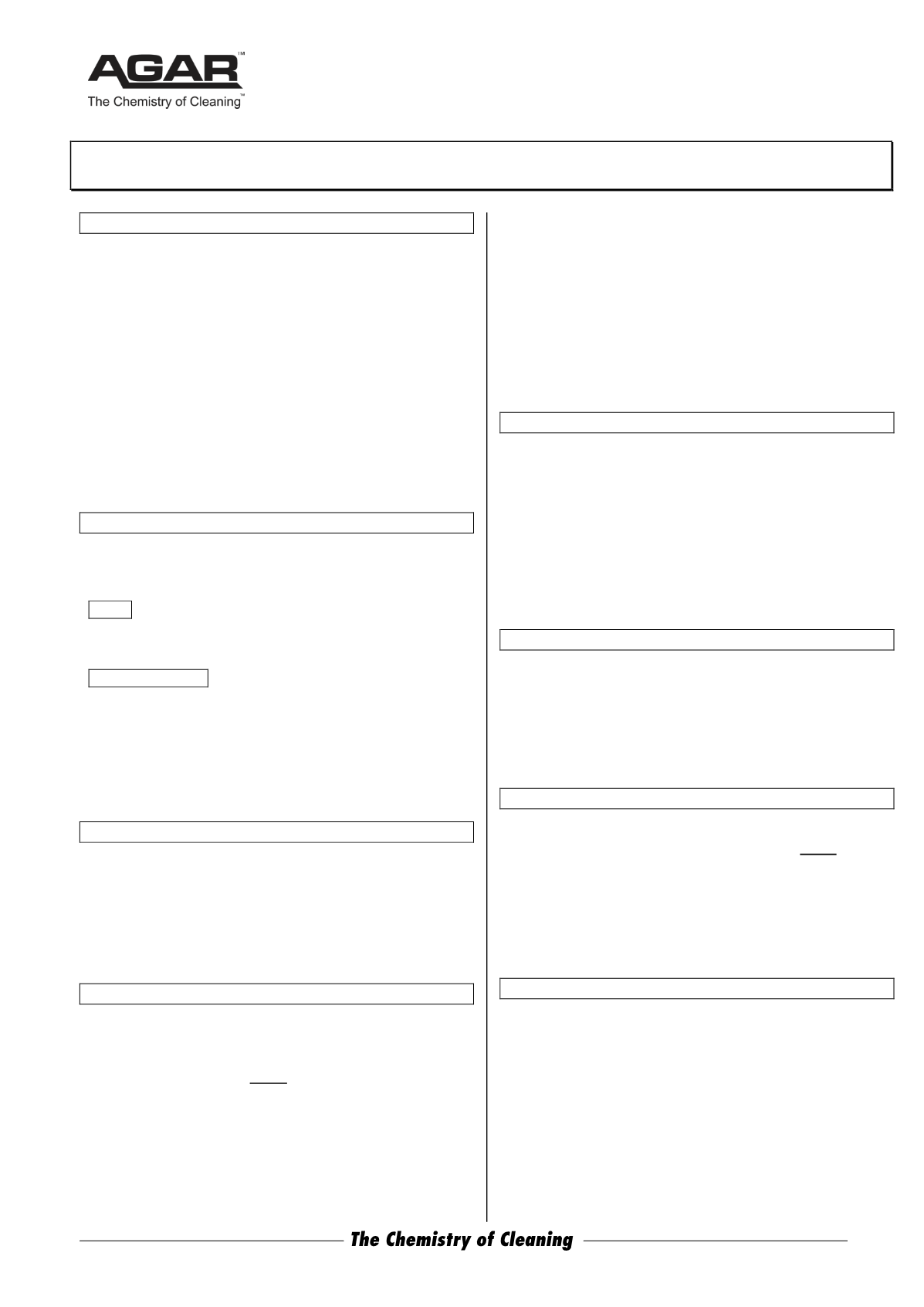

ABN 80 004 726 890 | MADE IN AUSTRALIA
VIC 03 9480 3000
NSW 02 9743 6020
SA 08 8293 2020
QLD 07 3274 3438
WA 08 9249 4566
Safety Data Sheet
Issued: November 23, 2014
Page 1 of 2
COMBI-OVEN CLEANER
1 IDENTIFICATION OF THE MATERIAL AND SUPPLIER
Product Name:
COMBI-OVEN CLEANER
Other Names: Caustic Alkali Liquid, N.O.S
Manufacturer's Product Code: COM
Product Use: Liquid alkaline detergent for removing fats, oils
and proteins from combination steamer/ovens.
COMPANY DETAILS
Company: Agar Cleaning Systems Pty. Ltd.
Address: 12-14 Cope Street, Preston, Vic. 3072
Telephone: 03 9480 3000 Facsimile: 03 9480 5100
Web:
www.agar.com.auAgar SDS are available from this website.
E-mail:
sales@agar.com.auEmergency Telephone Number: 131 126
(Aust wide)
2 HAZARDS IDENTIFICATION
Hazardous according to criteria of Safe Work Australia.
Corrosive C. Classed as Dangerous Goods.
Risks:
Causes severe burns.[R35]
Risk of serious damage to eyes. [R41]
Safety Directions:
Keep out of the reach of children. [S2]
In case of contact with eyes, rinse immediately
with plenty of water and seek medical advice. [S26]
Wear suitable gloves and eye/face protection. [S37/39]
In case of accident or if you feel unwell, seek
medical advice immediately (show the label
whenever possible). [S45]
3 COMPOSITION / INFORMATION ON INGREDIENTS
Ingredients:
Chemical Entity:
CAS No.:
Proportion:
Potassium hydroxide 1310-58-3 10%
Alkaline sodium salts < 10%
Dispersants non-haz < 10%
Other non-haz ingredients
< 10%
Water 7732-18-5 to 100%
4 FIRST AID MEASURES
Poisons Information Centre: Phone 131 126
Swallowed:
If poisoning occurs, contact a doctor or Poisons
Information Centre. Seek urgent medical assistance. If
swallowed, do NOT induce vomiting. Give a glass of water.
Rinse mouth with water. Never give anything by mouth to an
unconscious person. If vomiting occurs give further water to
achieve effective dilution.
Eye:
Immediately hold the eyes open and wash continuously for
at least 15 minutes with fresh running water. Ensure irrigation
under eyelids by occasionally lifting the upper and lower lids.
Removal of contact lenses after an eye injury should only be
undertaken by skilled personnel.
Skin:
Remove any contaminated clothing and shoes and flush
area with water. Seek medical attention in the event of
irritation.
Inhaled:
Risk of side-effects from inhalation is considered to be
low, but if effects occur, remove patient to fresh air. Apply
resuscitation if victim is not breathing. DO NOT use direct
mouth-to-mouth method if victim ingested or inhaled the
substance; use alternative respiratory method or proper
respiratory device. Administer oxygen if breathing is difficult.
First Aid Facilities: Eyewash facility.
Advice to Doctor: Treat symptomatically and as for strongly
alkaline corrosive materials.
5 FIRE FIGHTING MEASURES
Fire/Explosion Hazard: Product is not combustible.
Fire Extinguishing media: Water spray or fog. Foam. Dry
chemical powder. Carbon dioxide.
Fire Fighters’ PPE : Wear SCBA and chemical splash suit.
Fully-encapsulating, gas-tight suits should be worn for
maximum protection. Structural fire fighter’s uniform is NOT
effective for this material.
Special fire-fighting procedures: None.
Unusual fire hazards: None
Hazardous products of combustion: Thermal decomposition in a
large fire may yield toxic fumes.
6 ACCIDENTAL RELEASE MEASURES
Clean up all spills immediately. Avoid contact with skin and
eyes. Contain spill and mop up. Do not touch or walk through
spilled material. Place in a suitable, labelled container for waste
disposal.
If spilled on clothing, it should be removed and laundered before
re-use.
7 HANDLING AND STORAGE
Storage and Transport: Store in a cool, dry place. Store away
from acids. Keep containers closed at all times.
Never decant
this product into bottles, cups, glasses or other utensils
found in kitchens as this could lead to accidental
swallowing which could possibly be fatal.
Incompatibility (Materials to avoid for purposes of transport,
handling and storage only): Not to be loaded with dangerous
goods of Class 4.3, Class 5 or foodstuffs.
8 EXPOSURE CONTROLS / PERSONAL PROTECTION
Exposure Standards: None assigned for product.
Australian TLV for potassium hydroxide = C2.00 mg/cu.m TWA
[Source: Safe Work Australia HSIS- 2014]
Engineering Controls: Mechanical ventilation: Not required.
Personal Protection:
Gloves – Impervious natural rubber, butyl rubber, nitrile or
PVC gloves should be worn.
Note: Resistance of glove materials can vary. Evaluate
resistance under conditions of use and maintain PPE
carefully.
Please turn to page 2.


















